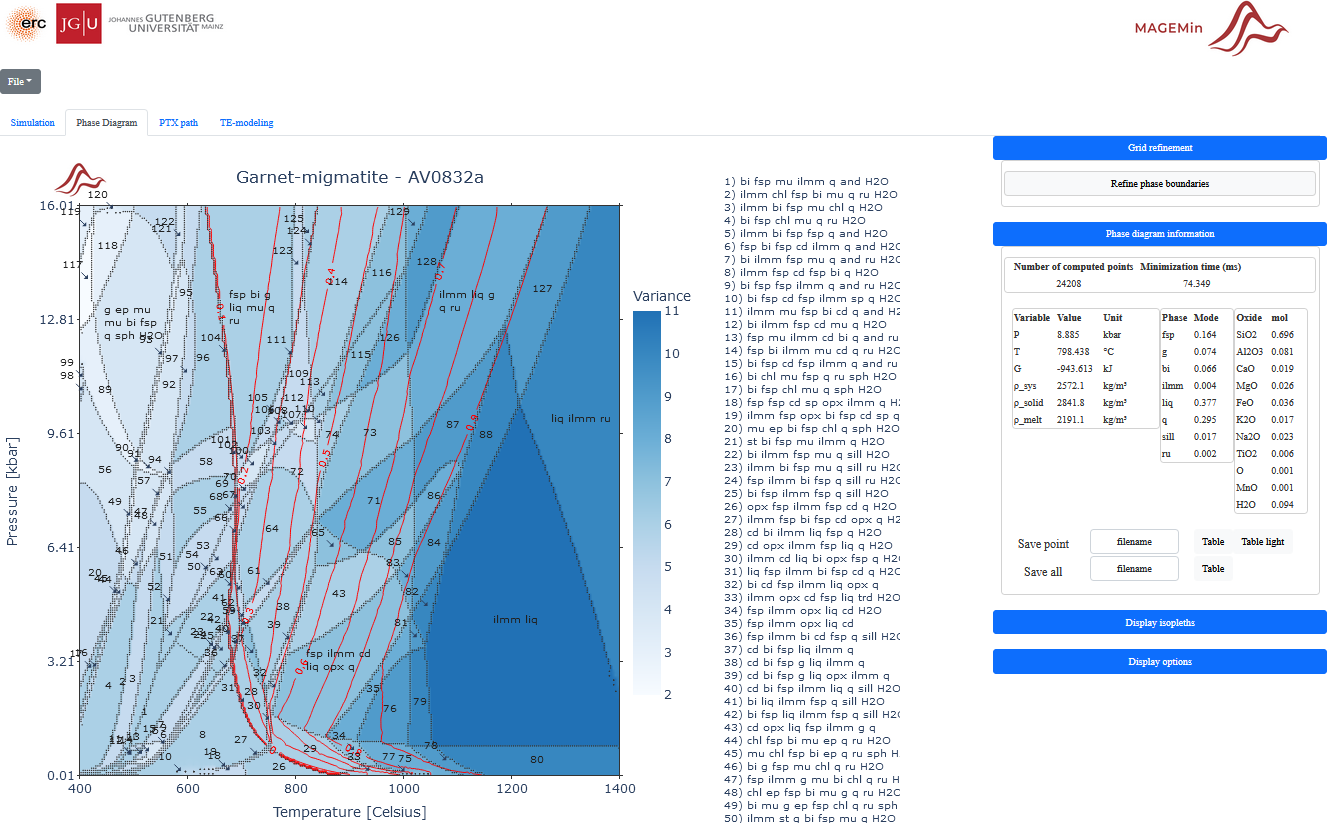MAGEMinApp.jl provides an easy-to-use web-based graphical user interface for MAGEMin. Available features:
- Compute Pressure-Temperature iso-chemical phase diagrams (P-T phase diagrams)
- Compute Pressure and/or Temperature versus variable composition diagrams (P-X, T-X, PT-X phase diagrams)
- Display iso-contour of phase fractions, densities, seismic velocities etc.
- Automatic labeling of the phase fields including listing the stable phase assemblage when the field is too small.
- Compute Pressure-Temperature path diagrams for fractional melting and crystallization.
- Save generated diagrams/figures as vector files (svg format).
- Export single point and whole grid information as table (ascii format)
As for MAGEMin, you can choose among several thermodynamic dataset: Metapelite (White et al., 2014), Metabasite (Green et al., 2016), Igneous (Holland et al., 2018) or Ultramafic (Evans & Frost, 2021).
To install MAGEMinApp:
julia>]
pkg> add MAGEMinAppAnd start it with:
julia>using MAGEMinApp
julia>App()
[ Info: Listening on: 127.0.0.1:8050, thread id: 2Next you can open 127.0.0.1:8050 in your favorite browser, which will launch the App.
MAGEMinApp is designed is such a way that bulk-rock composition must be entered in a *.dat file and loaded in the simulation tab. An example of valid bulk-rock composition file is given in examples/bulk-rock_ref.dat
- Commented lines must start with a
# - Bulk-rock composition line must contain
title; comments; db; sysUnit; oxide; frac; frac2 - A valid example of bulk-rock composition entry is for instance:
title; comments; db; sysUnit; oxide; frac; frac2
Test 2;Moo et al., 2000;ig;mol;[SiO2, Al2O3, CaO, MgO, FeO, K2O, Na2O, TiO2, O, Cr2O3, H2O];[48.97, 11.76, 13.87, 4.21, 8.97, 1.66, 10.66, 1.36, 1.66, 0.0, 5.0];\
Important
db must be either mp (metapelite, White et al., 2014), mb (metabasite, Green et al., 2016), ig (igneous, Holland et al., 2018) or um (ultramafic, Frost & Evans, 2021).
sysUnit must be mol or wt. Note that if wt is provided, the composition is converted and subsequently displayed in mol in MAGEMinApp.
oxide is the complete list of oxides of the selected database. You are not allowed to leave oxides out. If you don't need all oxides of the database simply set them to 0.0. Note, that either FeO and O or FeO and Fe2O3 can be provided. In the first case FeO = FeOt.
frac is the sysUnit proportion of oxides. Set the oxide content to 0.0 to reduce the chemical system. If possible, the calculation will be performed in a fully reduced chemical system, otherwise a low value will be automatically set (around 0.01 mol%). Generally, TiO2, Cr2O3, MnO, O and H2O can be effectively set to 0.0.
frac2 is used only when computing T-X or P-X diagrams.
Tip
For Windows machine you can launch a multi-threaded (parallel) version of the Julia terminal (to perform computation in parallel using MAGEMinApp) by creating a Julia_parallel.cmd file and adding the following lines (changing 8 to the number of threads your machine can support (type versioninfo() in a Julia terminal)). Then save the changes and execute Julia_parallel.cmd.
set JULIA_NUM_THREADS=8
C:\YOUR_PATH_TO_JULIA\bin\julia.exe
Caution
As of now, MAGEMinApp.jl remains under development and the current release is a beta version. Reporting issues, potential improvement and contributions are most welcome.
Important
In the simulation tab, bulk-rock composition are displayed in mol fraction. When using a bulk-rock composition file and the system unit is wt%, the bulk-rock are loaded and converted to mol%.
Important
When computing PTX paths (fractional crystalllization or melting), if an oxide reaches low concentration (< 1e-5 mol fraction) and if this oxide can effectively be set to 0.0, MAGEMinApp will automatically set it to 0.0. Conversely if the same oxide cannot be put to 0.0 with the current solution phase formulation, it will be set to 1e-5. This ensures stability of the algorithm.
